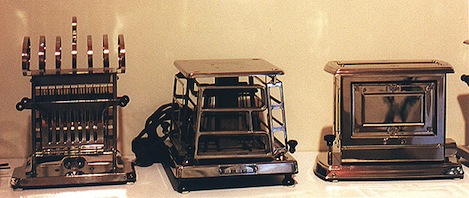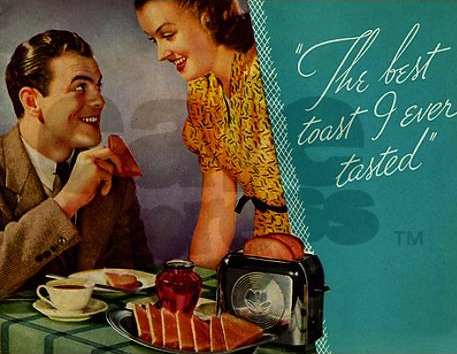A Toast to History Buffs
Florence Ditlow, May 13 2013
The tradition of a toast before a meal is possibly from sixteenth century England, where diners floated toasted bread in a hot alcoholic drink. Bread toasted, known as toast is derived from "toastare," the Latin word for to burn or to roast. Toast has proven to be a necessity and here are the lengths we have gone to perfect it.
Egypt is given credit for early ceramics that provided the first clay oven. Grain and water allowed naturally occurring yeast to make leavened bread dough. Egyptians learned to bake by containing heat in clay structures -- ovens capable of expanding the dough in hot air, thus making bread. Much of the improved flavor came from heating the natural grain's sugars in a browning process known as caramelizing.
Historically, bread once baked meant: where there's fire, there's toast! The bread just needed to be held by a stick or a metal rod over a fire or a fireplace. This went on for about 5,000 years prior to the invention of electricity.
The first electric toasters
Alan MacMasters in Edinburgh, Scotland invented the first electric toaster in 1893. Crompton, Stephen J. Cook & Company produced an electric, iron toasting appliance called the Eclipse. Hot iron tended to melt, however and electricity was undependable, slowing toaster usage.
With toast in mind, William Hoskins and Conner Neeson of Detroit invented "Chromel" in 1906. This was an alloy for use in electrical devices. A succession of people worked at inventing a commercially available toaster, but the first U.S. patent was granted to George Schneider from the American Electrical Heater Company of Detroit. This patent was filed concurrent to the design of "Chromel" wiring and probably utilized it.
 Sunbeam Model B Flat Toaster, Circa 1923. Porcelier No.5002 Electric Toaster, Circa 1930. Sunshine No.ST.1 Electric Toaster, Circa 1930.
Sunbeam Model B Flat Toaster, Circa 1923. Porcelier No.5002 Electric Toaster, Circa 1930. Sunshine No.ST.1 Electric Toaster, Circa 1930.General Electric applied for a patent application in 1909 for the GE model D-12, designed by technician Frank Shailor, and touted it as "the first commercially successful electric toaster" though it seems that it fell short of that claim.
Lloyd Copeman and his wife Hazel applied for various toaster patents in 1913. Their Copeman Electric Stove Company introduced one with automatic bread turner. The company coined the term, "toaster that turns toast." It appears that homemakers were not yet convinced, but the Copeman fortune finally was made with his invention of the rubber ice cube maker in 1928.
The Pop Heard Around the World
Charles Strite really made the toast pop in 1919 with a machine timed to heat your bread to around 310 degrees Fahrenheit, then pop it out. His invention was reworked by Waters Genter Company; in 1926 they introduced their Model 1-A-1 Toastmaster.
Electricity was more dependable by the twenties, ripening the market for electrical appliances. What fired up the world then was not only dancing "The Charleston", it also was sliced bread. Otto Rohwedder's first machine began to slice loaves in 1928 at the Chillicothe Baking Co. in Missouri. The machine also wrapped the bread to keep it fresh. The owner, Frank Bench, became the first commercial baker to slice loaves mechanically. Otto Rohwedder's invention was quickly adopted and the thirties saw Continental Baking Company introduce sliced Wonder Bread, with a machine of their own.
Sliced bread was what busy mothers wanted in 1928, and there was the toaster to streamline the family breakfast. Significant chrome designs were made by Sunbeam and General Electric. Newly improved toasters were luxury items, costing up to a whopping $25 in 1939. Toasters produced in the U.S. from the late 1930s through 1960 were durably made and due to workmanship, many have lasted to the present.
Early toasters took time to warm the heater elements, giving lighter slices on the first round, going gradually darker as more bread was toasted. Those made since the 1930's frequently use thermal sensors, such as a bimetallic strip, for uniform browning. The ejector was geared to a timing device, all important to get toast quickly, apply butter and avoid burnt fingers.
The American home required bread toasting machines with names like "Radiant" (1915), "Hold-Heet" (1921), and "Torrid" (1929). Get your favorite bread, toast it, top it and take the toaster tour here.

